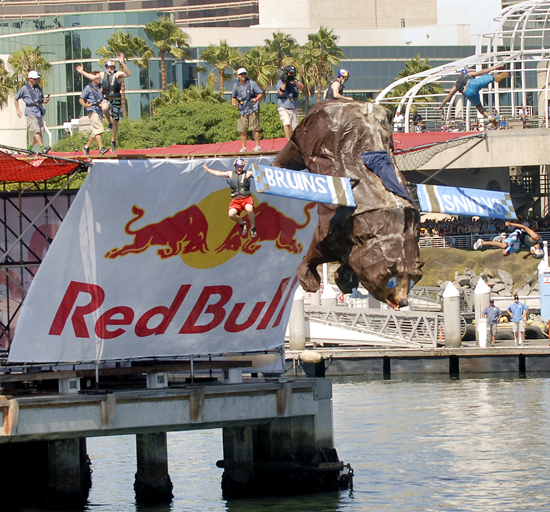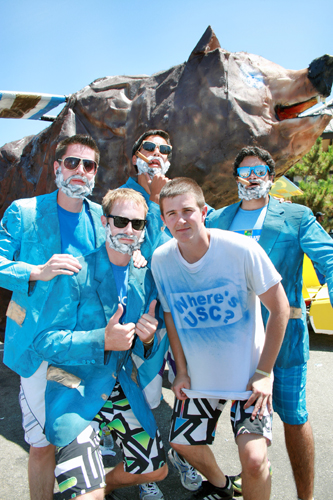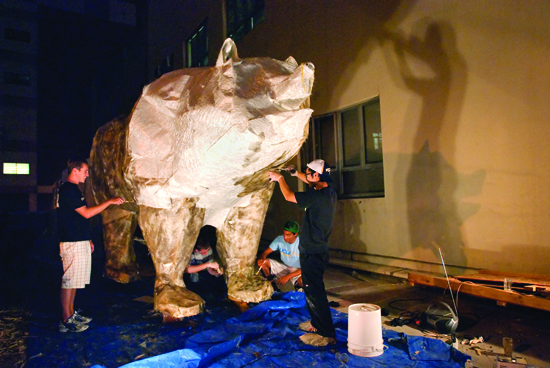
UCLA’s Band of Bruins get ready to launch its Bruin flugtag at Red Bull’s Flugtag competition. The competition took place in Long Beach on Saturday.

UCLA participants gather around their Bruin flugtag before setting it in motion.
He stepped, he jumped, he fell. And he kept falling.
Three-fourths of the way down the 30-foot plunge, Anthony Gambardella began scissor-kicking his legs, wondering when he would hit the water.
When he finally crashed, he landed face-first.
“My whole face was stinging, and I couldn’t see,” said the third-year mechanical engineering student, whose right eye was blind for 10 minutes afterward.
Gambardella’s face was intact, but the same couldn’t be said for the features of the bear-shaped aircraft floating upside down in the water behind him.
On Aug. 21, Gambardella and his UCLA friends competed in front of about 105,000 spectators at Red Bull Flugtag in Long Beach’s Rainbow Harbor.
Each team built a human-powered aircraft, stuck on a pilot, and pushed it off a 30-foot-high pier. Most of these bizarre contraptions, which ranged from a flying dinosaur to a flying car, dropped straight into the water.
Gambardella’s team, dubbed Band of Bruins, made a replica of the Bruin statue. Spray-painted brown, with formidable teeth and wings, the aircraft stood 10 feet tall and 15 feet long.
“(The competition) was the first time I’d been up on the bear at all. I got up with the ladder, I squatted down, and they started pushing. As soon as the head went over the edge, I stepped onto the head and jumped,” said Gambardella, who piloted the craft and landed 39 feet out in the harbor. His four teammates also jumped, splashing into the water around him.
Flugtag, which means “flying day” in German, comes to U.S. cities every couple of years. It always attracts numerous college teams, said Scott Houston, Red Bull communications manager.
A Cal Poly San Luis Obispo student team called Peepin’ It Real took first place with its giant aircraft modeled after marshmallow Peeps. The team included a UCLA student, Suzy Strutner, who is a second-year undeclared student and a Daily Bruin contributor.
Before each flight, teams performed a short skit. Members of Band of Bruins donned blue suit jackets for their parody of the Dos Equis beer “The Most Interesting Man” commercials, calling UCLA the “The Most Interesting University in Los Angeles.”
“We want to be as energetic as possible,” Gambardella said before the competition. “This thing’s really not going to fly. Though we like to say, you’ll never see a bear fly farther than ours.”
The bear didn’t catch much air, but Band of Bruins still received high scores, landing in the top half of 35 teams. Distance is only one of the criteria judges look for ““ creativity and showmanship are just as important.
The beginning
“It was one of those stupid procrastinating nights in the dorm,” said Peter Wardell, a third-year mathematics and economics student. “Anthony (Gambardella) and I will find anything to distract each other, and we started watching flugtag videos.”
What began as a casual conversation between roommates soon turned into a long-term project for their group of friends.
“It’s something to say, “˜Look what I did,’ when everyone is old and hairy,” Gambardella said. “If we can do it, why don’t we?”
The team quickly completed its application to meet the May deadline, sketching a basic design in three minutes. The team’s first idea was to make a flying Royce Hall, but scrapped it in favor of the bear.
“There wasn’t too much planning,” said Adam Uchimoto, a third-year biology student. “That’s the whole story of the project ““ just winging it and it turning out really well.”
For the Long Beach competition, Red Bull received about 400 applications, Houston said. Out of several UCLA-based teams, Band of Bruins was the only one accepted.
“A guy from Red Bull called us and grilled us. He asked us about money, where we were going to work, how we were going to get to Long Beach,” Gambardella said. “I can see why they made the application process so difficult ““ you have to be committed to do this.”
How to build a gigantic bear
The Band of Bruins members have varied engineering backgrounds. Gambardella and third-year mechanical engineering student Anthony Tyson have built everything from a tree house to a car since they were kids. On the other hand, their friends’ construction experience is largely limited to Legos.
But for all the team members, the bear was the largest project they had ever taken on. They started out with a rectangular wood frame, then molded the bear’s shape with chicken wire ““ an idea initially suggested by Wardell’s mother, an art teacher.
They covered the wire with cloths of woven fiberglass threads, painting over the glass with resin.
The aircraft was supposed to cost $500, but the team members ended up spending twice that amount, mainly out of their own pockets.
“We’re open to post-(competition) sponsorship,” Uchimoto said.
But the biggest obstacle by far was what Tyson termed “the bear-pig problem.”
“The face took a lot of shaping to make it look like a bear,” said Uchimoto, who estimated they spent 20 hours working on the bear’s features.
They used pictures of the Bruin statue and a stuffed animal bear as guides. And while sculpting the face, team members would skateboard to the actual statue every so often to make sure they were on the right path.
The last night before liftoff
It is the night of Aug. 19, and a three-quarter moon punctures the black sky above Engineering I.
Behind the building, a narrow walkway provides a workshop for the team and a home for the unfinished bear.
In this space, a few members scrub bits of excess fiberglass off the bear using knives and metal brushes.
“Do you think we’re going to be here all night?” asked Evan Seder, a third-year economics student.
“Yes,” Gambardella answered.
His reply rings true ““ they end up staying until 6 a.m. After all, tonight is the last night they have to work on the bear before loading it in a 20-foot trailer and driving it to Long Beach.
The team only gathers after 9 p.m. because most of its members have day jobs ““ a typical schedule includes about eight hours of work followed by aircraft construction, which usually lasts until 1 to 3 a.m.
They also started building the bear three weeks before the competition, and are now pressed to finish it. Other teams started months in advance.
“You don’t get a ton of sleep,” Wardell said. “Some days (the bear) gives you something to look forward to. And then sometimes, it’s like you know you have four to five hours of work tonight and you’re wiped.”
As they prep the bear for a coat of spray paint, team members occasionally make brief comments to each other. Music from a boom box fills large lapses in the conversation ““ the first track on the CD is Phoenix’s “Lisztomania,” which has become the theme song of the project, Gambardella said.
As his friends began layering paint on the bear, Wardell said the project embodies what college is all about: They are spending hours working on a bear they will eventually destroy as thousands of spectators watch.
“It’s one of those moments you look back and say, “˜You remember when we did this really stupid project?'” Wardell said. “I feel like I’ve wasted an entire summer, but it’s been a lot of fun.”
